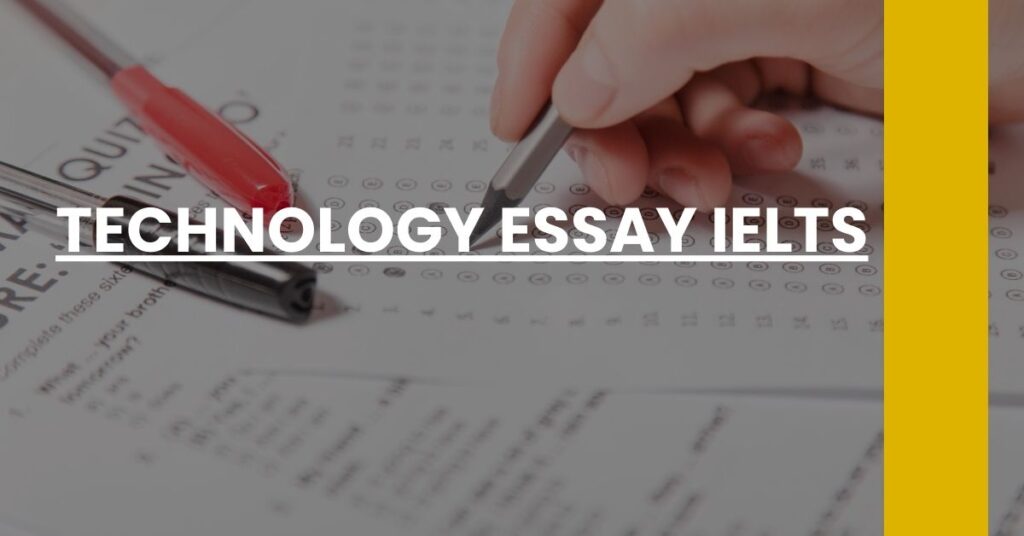Mastering the technology essay IELTS challenge starts here.
- IELTS Writing Task Success: Equip yourself with techniques for crafting insightful technology essays.
- Thrive in Technology Topics: Stay ahead of current tech trends for your IELTS mastery journey.
- IELTS Essay Excellence: Enhance your writing with industry-driven technology vocabulary.
Write a standout technology essay for IELTS with confidence.
- Understanding the IELTS Essay Task
- Planning Your Technology Essay
- Writing the Introduction
- Developing Body Paragraphs
- Citing Examples and Evidence
- Addressing Opposing Views
- Concluding the Technology Essay
- Sample Technology Essay Topics and Responses
- Preparing with Technology Vocabulary
- Conclusion and Further Resources
Understanding the IELTS Essay Task
When you’re gearing up to take the IELTS exam, it’s critical to master the art of essay writing, especially when it comes to technology topics. The IELTS Writing Task 2 is your chance to shine, showcasing your ability to present a well-structured argument in response to a prompt. This task is not just about writing; it’s about constructing your thoughts in a way that resonates with the examiner.
What Exactly is the IELTS Writing Task 2?
Writing Task 2 requires you to craft an essay of at least 250 words within 40 minutes. Sounds daunting? With the right approach, it doesn’t have to be. The essays can cover a range of topics, but with technology playing an omnipresent role in our lives, it frequently becomes the focus of these tasks.
Why Focus on Technology Essays?
The reason is simple: technology essays tap into current and relevant discussions, from the rise of artificial intelligence to the ethical dilemmas posed by data privacy. Your ability to discuss these topics thoughtfully is crucial not just for the IELTS, but for engaging in modern societal discourse.
For more details on the Writing Task 2, you might find IELTS Writing Task 2 guide helpful.
Planning Your Technology Essay
Before you dive headlong into writing, a well-thought-out plan is your best ally. Planning helps to organize your ideas and ensure that your essay is coherent from start to finish. Think of it as a roadmap guiding you to your final destination: a compelling and cohesive essay.
Break Down the Prompt
Start by dissecting the essay prompt: what is it asking you to do? Is it an argument to be discussed, a problem to be solved, or a discussion of the benefits and drawbacks of a particular technological advancement?
Formulate a Thesis Statement
Your thesis statement is the backbone of your essay. It drives the direction of your argument and provides a glimpse of what’s to come. Make it clear and assertive.
Structure Your Main Points
Now, brainstorm the main ideas that will form your body paragraphs. Each should revolve around a central point that supports your thesis.
- First key idea: This could be a discussion of how technology improves efficiency in various aspects of life.
- Second key idea: Conversely, consider the impact of technology on human relationships or privacy concerns.
For structuring your content, the universal essay structure recommended by Writing Lab can be immensely helpful.
Writing the Introduction
The introduction is the gateway to your essay. It sets the stage for everything that follows, so it’s essential to get it right. The key here is precision and engagement.
Hook Your Reader
Begin with an intriguing statement or a compelling fact about technology that catches the reader’s attention.
Provide Background Information
Give a nod to the importance of the topic. For a technology essay, you could mention the ubiquity of digital devices in our daily lives.
Present Your Thesis
Your thesis is the star; make sure it shines by stating it clearly and boldly, summarizing your main argument.
For crafting an introduction that hooks the reader, the guidance provided by IELTS Advantage could serve as an invaluable resource.
Developing Body Paragraphs
A strong essay is built on the foundation of solid body paragraphs. Each one should be a beacon of your argument, shining its light on a different aspect of the technology topic at hand.
Organize Your Arguments
Each paragraph should start with a topic sentence that encapsulates the main point you’re about to explore. What follows is a dance of evidence and examples that bolster your claim:
- Start with a claim or argument, linking it back to your thesis.
- Provide evidence, data, or an example that supports your point.
- Analyze the evidence: why does it matter in the context of your argument?
- Conclude the paragraph by tying it back to the overall thesis of the essay.
Use Connecting Words
Connective words or phrases, such as ‘furthermore’, ‘however’, or ‘consequently’, ensure that your paragraphs flow smoothly from one idea to the next.
Cite Reliable Sources
When illustrating a point with an example, particularly in a technology essay, citing credible sources adds weight to your argument. Mention a study on how e-learning platforms are revolutionizing education or cite stats on global internet usage.
Mastering the art of forming coherent and persuasive body paragraphs is crucial and can be mastered with practice and by following the sound advice found on Writing Lab.
Remember, when tackling a ‘technology essay IELTS’ task, the depth and clarity of your argument matter immensely. Spend time understanding what the question asks for, structuring your thoughts, and articulating your points with precision, and you’ll be on your way to IELTS success.
Citing Examples and Evidence
In a technology essay IELTS task, examples and evidence are not just garnish; they are your main course. When you demonstrate your point by citing real-world instances or data, you validate your argument and illuminate your insights.
Why Are Examples and Evidence Crucial?
- Supporting Your Claims: Without evidence, your claims are just opinions. Evidence transforms your opinions into reasoned arguments.
- Demonstrating Your Understanding: Using examples shows that you can apply theoretical knowledge to real-world scenarios, a key skill in any field.
- Boosting Your Credibility: When you cite reputable sources, your essay inherits a level of trust and authority.
How to Integrate Examples and Evidence
- Identify the Claim: Each paragraph should begin with a claim that you need to prove.
- Search for Evidence: Look for statistics, case studies, or expert opinions that support your claim.
- Analyzing the Evidence: Don’t just state the facts. Explain why the data supports your claims and its relevance to the topic.
- Cite Your Sources: Mention where your evidence comes from to boost your credibility.
An excellent way to practice this is by incorporating data on technology’s impact on everyday life. Mention the rise of telemedicine, for example, providing statistics on patient satisfaction or efficiency improvements.
For guidance on using precise examples and evidence, check out how to effectively support arguments in your IELTS Writing Task 2 Sample Answer.
Addressing Opposing Views
When crafting a technology essay IELTS aspirants might overlook the importance of counterarguments. Addressing the flip side not only showcases critical thinking but also reinforces your position as well-grounded and well-considered.
How Should You Address Opposing Views?
- Acknowledge: Briefly present the opposing perspective. Show that you understand it’s a valid point of view.
- Refute: Use evidence to explain why this viewpoint may be incomplete or less relevant in the context of your argument.
- Integrate: Seamlessly weave this rebuttal into your essay without allowing it to overshadow your primary argument.
What if someone argues that technology creates a dependency? You could counter by discussing the empowerment that comes from informed usage or highlight skill development through tech platforms.
For strategic ways to present counterarguments, take a look at how it can elevate your writing score on KeytoIELTS: Counter Arguments.
Concluding the Technology Essay
The end of your technology essay IELTS exam is near, but there’s one more hurdle: the conclusion. It’s where you tie up loose ends and leave a lasting impression.
Components of a Strong Conclusion
- Restate Your Thesis: Bring your reader full circle by reaffirming the stance you took in the introduction.
- Summarize Key Points: Touch on the main arguments you’ve made, reinforcing the strength of your position.
- Leave with a Thought: End on a high note with a final reflection or call to action that underscores the significance of the topic.
Remember, a powerful conclusion can tip the scales in favor of a higher band score. Aim to encapsulate your argument succinctly and confidently.
Reviewing and Editing
Drafting your essay is just the beginning. The refinement phase—reviewing and editing—is where good essays become great.
Polishing Your Essay to Perfection
- Check Your Structure: Review the flow of your ideas. Is your argument logical and easy to follow?
- Look for Clarity: Eliminate any ambiguity. Your sentences should be fueling understanding, not confusion.
- Refine Your Vocabulary: Industry-specific tech terms can elevate your essay, but only if used correctly.
- Fix Grammar and Spelling Errors: Such mistakes can distract from your message, so sweep your essay clean of them.
For meticulous proofreading tips, turn to general IELTS writing guidelines and scrutinize your work for responsiveness to the task, coherence, and linguistic accuracy.
Sample Technology Essay Topics and Responses
Preparing for a technology essay IELTS style means familiarizing yourself with potential topics. Let’s look at a few sample topics and the skeleton of a solid response:
- Impact of the Internet on Social Behavior
- Advancements in Educational Technology
For each topic, devise a thesis, flesh out supporting points, and consider potential rebuttals. Dive into sample IELTS Task 2 Questions to practice.
Preparing with Technology Vocabulary
One of the keys to a great technology essay IELTS task is the use of apt vocabulary. The technology field has its lexicon, and familiarity can make the difference between a generic essay and one that speaks with authority.
Enhance Your Lexical Resource
- Industry Jargon: Learn terms like ‘the cloud,’ ‘blockchain,’ and ‘augmented reality.’
- Descriptive Adjectives: Words like ‘innovative,’ ‘revolutionary,’ and ‘cutting-edge’ can add color to your narrative.
- Verbs and Phrasal Verbs: Use action words like ‘streamline,’ ‘navigate,’ and ‘roll out’ to describe technology applications and advancements.
You’ll find an extensive list of IELTS-worthy technology terms on Vocabulary Lists that could enhance your preparation.
Conclusion and Further Resources
As you draw your preparations for the technology essay IELTS to a close, remember: understanding the prompt, building a structured argument, and refining your language are the foundations of essay success. Keep expanding your knowledge and practicing with a wealth of available resources, and you’ll be poised to excel.
Master technology essay IELTS writing with expert tips, sample topics, and vocabulary to ace the exam. Improve your score now.

